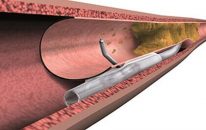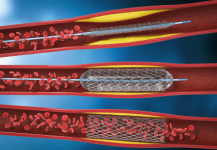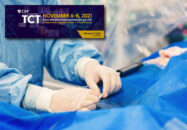Lecture by Dr. Hector García García – LM-PCI: IVUS and FFR/IFR? Dr. Hector García delivered an excellent presentation on whether we should use intravascular ultrasound (IVUS) or fractional flow reserve (FFR)/instantaneous wave-free ratio (iFR) in the left main coronary artery (LMCA) to consider severe obstruction, since there is significant interobserver variability with angiography. Although the…
The Best of the SOLACI-SOCIME 2022 Main Arena: PCI by Radial Access
Angioplasty by transradial access was discussed during a session on Day 2. We were pleased to participate in a conference by Dr. Shigeru Saito on distal radial access. Currently, complications associated with transfemoral access are well-established, so transradial access is suggested as the initial strategy in several guidelines of various associations. However, Dr. Saito shared…
The Best of the SOLACI-SOCIME 2022 Main Arena: Complex PCI Guided by Intravascular Imaging
In the first session of SOLACI-SOCIME 2022 on “Complex angioplasty guided by intravascular imaging”, Dr. Alejandro Diaz (MEX) reviewed the evidence on intravascular ultrasound (IVUS) in complex angioplasties. A meta-analysis indicated its use is associated with a significant decrease in the risk of death, acute myocardial infarction (AMI), and new target lesion revascularization (TLR) in…
Progress-CTO Score: A Key New Tool to Plan CTO
Intervention of chronic total occlusions (CTO) through angioplasty (PCI) can cause complications, even in highly experienced centers. Plenty has been written on the probability of success for the treatment of CTOs using scores such as CL-SCORE, J-CTO, ORA, E-CTO, CASTLE-CTO, etc. (some of which are usually used when preparing these cases). However, besides estimating success…
Changes in Coronary Collateral Function Post CTO Intervention
In the last few years, we have seen significant growth of chronic total occlusion (CTO) percutaneous intervention, which has also been considered for patients with viable territory that remain symptomatic. Experienced centers present successful CTO intervention rates close to 90%, especially with a hybrid approach. However, it is still a complex procedure, and target vessel…
Angioplasty in Nonagenarians Is Increasingly Frequent: How Does It Evolve?
Currently, the number of nonagenarian patients undergoing angioplasty (whether elective, urgent or emergency) has increased. This population is linked to more comorbidities and has barely been included in most randomized studies or registries. As such, we do not have robust evidence on this group. Researchers conducted an analysis of the J-PCI OUTCOME Registry, in which…
Three-Year Outcomes after CTA with 2-Stent Technique Vs. Provisional Stenting for Complex Bifurcation Lesions
The prevalence of coronary lesions with bifurcation involvement is about 20% in patients undergoing coronary angiography (CTA). While provisional stenting is overall the most accepted technique, the 2018 myocardial revascularization guidelines recommend the 2-stent technique for complex bifurcation lesions, defined as side branch with lesion >5mm, distal reference diameter of the side branch ≥2.75, or…
PCI on Native Arteries or Saphenous Vein Grafts: Which Has Better Prognosis?
New revascularization after coronary artery bypass graft (CABG) is often needed, be it because of severe bridge lesion, intimal hyperplasia, thrombosis, atherosclerosis, or native vessel lesion progression. We therefore need to determine the best revascularization strategy, namely native or graft percutaneous intervention, venous or arterial, or repeat surgery, with the risk it entails. There is…
TCT 2021 | FAME 3: Surprises in a Long-Awaited Study
Angioplasty could not reach non-inferiority to surgery to treat patients with three-vessel lesions. In this head-to-head study of both revascularization strategies in patients with three-vessel coronary disease, fractional flow reserve (FFR)-guided angioplasty could not reach the performance of myocardial revascularization surgery in relation to a composite of adverse events. The FAME 3 study was presented during…
TCT 2021 | SUGAR Trial: Polymer-Free Stent in Diabetes
In CAD patients with diabetes the polymer-free amphilimus-eluting stent resulted non-inferior to the polymer-based zotarolimus-eluting Resolute Onyx. This new device, in addition to ultrathin struts, has already been found non-inferior to the Resolute Integrity in the general population at 3-year followup. Researchers believe that the new amphiphilic carrier might be especially useful in diabetic patients…









